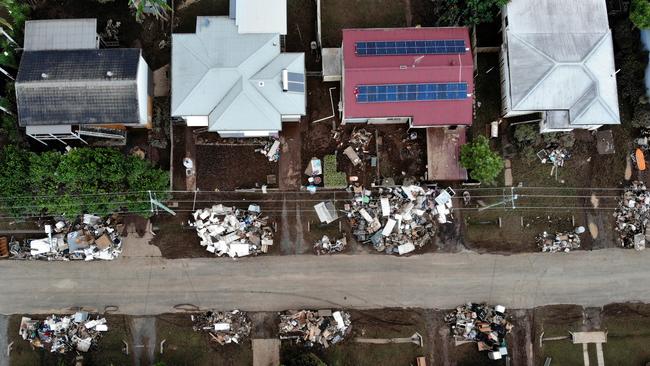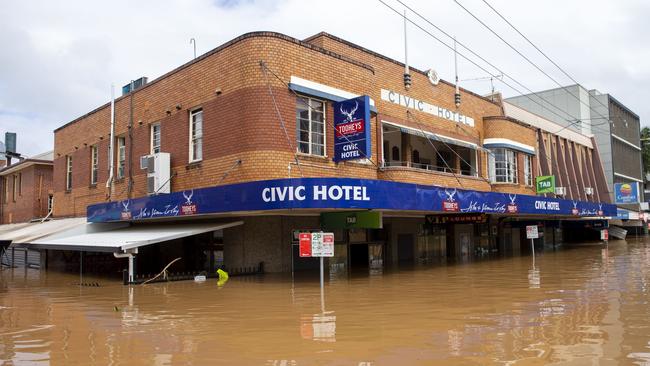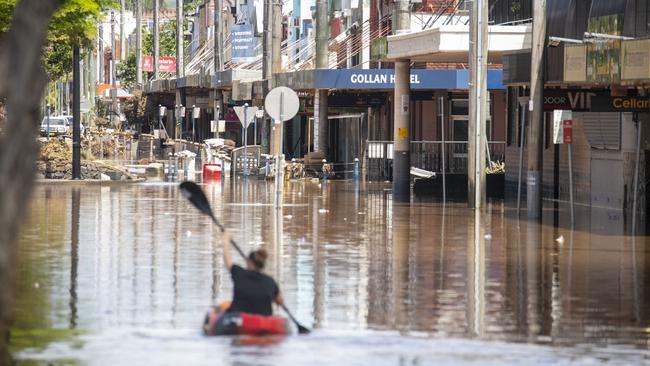Lismore locals have spent decades proposing well-researched and affordable engineering solutions to limit flood devastation – but there has never been any action by government.
Since the 1960s, mitigation plans have been developed only to end up covered in dust, while the beleaguered city has ended up inundated repeatedly.

Still, there are hopes that the current unprecedented catastrophe might finally lead to action with Prime Minister Scott Morrison yesterday pledging multimillion-dollar flood mitigation works for the embattled area.
“It’s going to require a lot of political will,” warned local Bill Moorhouse, who was Lismore’s city engineer from 1987 to 2005 and a councillor from 2016 to 2021.
Mr Moorhouse, who was also Richmond River Council engineer from 2005 to 2020, is calling for a “mini Snowy scheme” of dams that would not only mitigate flood damage but aid the town in very dry times.
“I think that would be the ultimate solution,” he said.
Mr Moorhouse said he expects fierce opposition from supposed environmentalists to the idea of building dams.
“Imagine all the Greenies coming out of the hills not wanting to do that,” he told The Daily Telegraph on Wednesday.
He has previously advocated for – and continues to favour – elements of a plan produced in the 1980s by prominent local, the late Floriano Volpato.
“It still has merit,” Mr Moorhouse said.

At his own expense, Dr Volpato brought to Lismore from Italy a team of leading urban hydrologists to analyse mitigation options, leading to a plan for a series of levees and diversion canals.
After yet another devastating flood in 1989, Dr Volpato wrote to then-federal Primary Industries and Energy Minister, Labor’s John Kerin, seeking support.
The proposal had two stages. The cost of the first stage was put at just $6 million, or $12.5 million allowing for inflation. The second stage was not costed.
“There is nothing new in this proposal – it was planned to be carried out in 1968,” Dr Volpato wrote.

“Imagination and a positive approach will quickly demonstrate its worth. It has to be done and is justified now.”
But it was not done.
“And 30 years later, still nothing has been done,” said Beth Trevan of the Lismore Citizens Flood Review Group.
In 2017, Mr Kerin published a 726-page book on his time as Primary Industries Minister. It made no mention of Lismore’s flooding problem. Mr Kerin declined to comment when contacted on Wednesday.

In the early 1990s, after a devastating flood, the Lismore Chamber of Commerce raised donations to fund an investigation by major structural engineering firm Sinclair Knight, which developed options that again included levees and canals that it predicted would have delivered “major decreases in flood levels”.
Instead in 1999 a less substantial compromise proposal for a one-in-10-year flood levee for the CBD was agreed to. This was seen by some as an equitable outcome because South Lismore only had a similar level of protection.

An earlier push for a one-in-20-year CBD levee had been rejected for being too costly.
The 1:10 levee was finished in 2005 and did protect the CBD against a major flood in 2009, but it was “overtopped” when even higher waters hit Lismore in 2017.
The damage bill for the 2017 flood has been put at $3 billion.
The current catastrophe is likely to be even more expensive.
Like Mr Moorhouse, Ms Trevan has not given up hoping that there will be meaningful action on mitigation.
“I want to see something started before I die,” the octogenarian said.
“There should be a whole of catchment, whole of system evaluation by the very best brains in the country.”
Meanwhile, a former Lismore mayor argued that it was now up to the city to “build back better” after the devastating floods.
Jenny Dowell, who led the city’s council from 2008 to 2016, said Lismore had to use Darwin and Cyclone Tracy as an example.
The Northern Territory capital had continued to be battered by cyclones, but its buildings were now able to withstand them. “We have to build back better,” she said.
For example, replacement dwellings and other structures needed to be designed so that their contents could be raised above major flood levels.

Add your comment to this story
To join the conversation, please log in. Don't have an account? Register
Join the conversation, you are commenting as Logout
‘F**k off’: Ex mayor unleashes over coriander in Christmas buffet
A former mayor swore at councillors and left a chef distressed after being offered food at a Christmas buffet covered in what she believed was coriander.
Cold coke: $9m haul found in refrigerated shipping container
The 27kg of cocaine is the latest detection in a cold shipping container, with authorities now boasting of discovering 170kg of the drug in refrigerated containers coming into Australian ports since October.